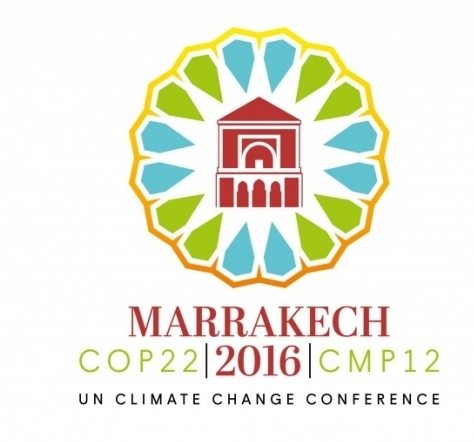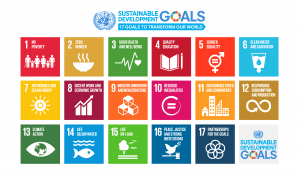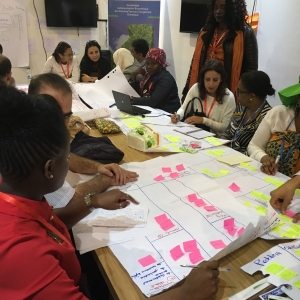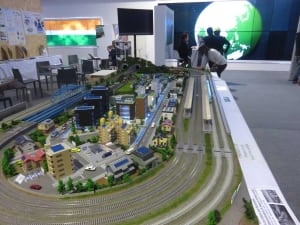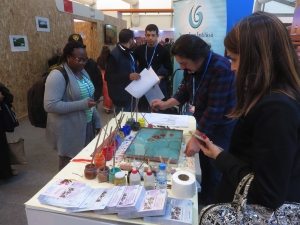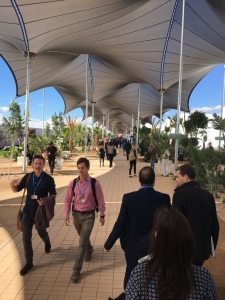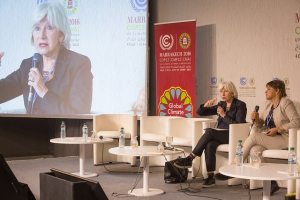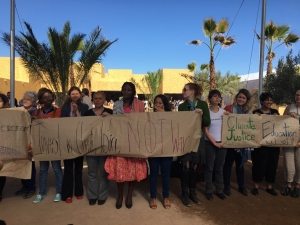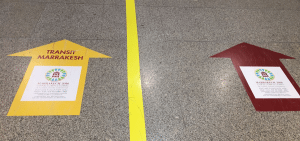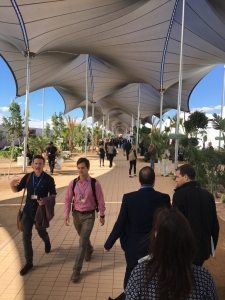CLIMATE ACTION IS UNSTOPPABLE!
Last night, countries unanimously joined together to support the Marrakech Action Proclamation, which celebrates the irreversible momentum that led to the Paris Agreement and the bold initiatives by governments, businesses, cities and people around the world to address climate change and achieve the Sustainable Development Goals.
To read more about the Marrakech Action Proclamation, please visit: http://bit.ly/2faMfgM
Winding down
On the last day of COP22, the customary hustle and bustle of Bab Ighli–the site of the conference–gave way to a quietness interspersed with sporadic singing. It was, after all, Moroccan Independence Day. As the day wore on, the tent village showed signs of closing up.
Many high level officials have left. UN Secretary-General Ban Ki-moon met with civil society members before departing to thank them for their support during the process leading up to Paris, and expressed hope that they would remain engaged.
The negotiations themselves continued into the evening. Discussions on a host of issues—mostly technical and procedural, were still being held. In one sense, the swiftness of the entry into force of the Paris Agreement caught everyone off guard—the plan had been to write the rulebook while the ratification process continued, but that process has to be accelerated. There are now 111 countries that have joined the Agreement.
A sense of achievement
There is a palpable sense of satisfaction here, with upbeat statements all around. COP22 President Salaheddine Mezouar, who convened a wrap-up press conference while negotiations were still underway, highlighted the Marrakech Proclamation of Climate Action and the Partnership for Global Climate Action as the conference’s main outcomes. The COP had refocused global attention on the implementation of the Paris Agreement.
On the one hand, the political commitment to implementing the Paris Agreement has been revived in the most ardent fashion with the Marrakech Proclamation. But the central question of whether systems will be put in place quickly enough to bend the current emission trajectory and steer clear of 2°C rise in temperature remain a continuing global concern and challenge.
Most Vulnerable Countries Take Charge
Developing countries, including Small Island States and Least Developed Countries, showed that they were willing to lead by example. The Climate Vulnerable Forum, a collection of 48 countries that are most vulnerable to the impacts of climate change, and probably among the least able to afford major efforts to reduce emissions and build climate resilience, laid down a challenge to the rest of the world by announcing that they would make the effort to use 100 percent renewably generated energy by mid- century.
Marrakech reminded everyone that climate change is already here and that those who contributed the least to creating the problem are likely to take the brunt of its complex, far-reaching and costly impacts. Developed countries reaffirmed the “US$100 billion per year by 2020” pledge, which developing countries consider essential for furthering trust and cooperation
Another take-away message from Marrakech is that ecosystems, not technology, must be at the center of the global response to climate change. Throughout the conference, UNEP, FAO and other UN agencies stressed the importance of factoring agriculture, forests, arid lands and oceans into environmentally sustainable decarbonization strategies.
Today, it was announced that the COP22 Presidency will hold a meeting in January 2017 with UNFCCC and civil society “to take stock and create a common roadmap”. There is still quite a bit of a journey ahead.
شكرا
Shukraan, Marrakech!
17 November – Day 10
The final outcome of Marrakech won’t be known for at least another day, but a good deal is clear. For starters, there is universal support, from country delegations and civil society, for the Paris Agreement. There is satisfaction that the Agreement serves as a solid starting point for action. And there is satisfaction that the Agreement has entered into force in less than a year after Paris—110 countries have joined so far. But there are worries, going forward. The science provides little solace from the fact that there is an agreement, as it is clear that 2016 is well on its way to becoming the hottest year on record. And there is political uncertainty over whether changes in political leadership will affect implementation efforts. In any case, parties have expressed uniform determination to advance implementation.
Good News/Bad News on Energy
There are some good signs on the global energy front, according the 2016 World Energy Outlook report issued by the International Energy Agency. The growth of energy-related CO2 emissions stalled in 2015 and increasing portion of the $1.8 trillion in energy investments are going to clean energy. But the bad news is that there will be a 30 percent rise in the global energy demand by 2040 which will mean an increase in demand for all fuels, including oil, coal and gas.
Memorize the Sustainable Development Goals
Asked what people can do to help address climate change and sustainable development, Steven Sachs, UN Special Advisor on the SDGs, unhesitatingly said, “memorize the 17 SDGs. These are a shared commitment to decency.” He added, “these are wonderful goals. Let’s get on with it.”
Scientifically speaking, Africa’s Great Green Wall is possible, but…
The Great Green Wall, “Africa’s flagship programme to combat desertification” is a dream for some, unrealistic and even a waste of time for others. But the idea has been resilient, almost like the Saharan species and ecosystems that continue to thrive or survive in the harsh Saharan environment. After long years of experiences and studies, the Food and Agriculture Organization (FAO) and its partners launched a “groundbreaking map of restoration possibilities” along the African great wall–an inventory of what could be done to restore this area of 780 million hectares of degraded lands and home to 232 million people. Scientifically speaking, 166 million hectares of the area can be restored to halt and or reverse the trend of land degradation. And for that to be achieved, each year 10 million hectares should be restored. Evidence collected and lessons learnt during many years of implementation, scientific studies and assessments show that the dream is possible. FAO’s map provides new avenues for the preventive diplomacy to go far beyond “business as usual.”
The early birds of implementation
Representatives developing and developed countries alike underscored the need to turn the Paris Agreement from a ground-breaking political achievement to a practical blueprint for a sustainable, climate-resilient world. All declared that there is no shortage of political will nor a lack of engagement from civil society. But how do we get there? The good news from Marrakech is that no one is sitting on their hands and waiting for an answer. The positive energy unleashed by the Paris Agreement seems to have galvanized global climate action: from small island states to oil-rich countries, everyone is doing something. For example, the Marshall Islands, which is facing an existential threat from sea-level rise, is committed to drastically reduce emissions and, provided international support is made available, to achieve net-zero emissions by 2050 or earlier. And the UAE, the world’s 6th largest hydrocarbon exporter, launched the World Green Economy Organization – “a platform for sustainability, green business and innovation.” UAE has proudly announced that its economic diversification has paid off: “today, the UAE’s non-oil sectors contribute to more than two third of the country’s gross domestic product.”
Adaptation is not a luxury
When it comes to action, there is a great need to prioritize adaptation, said Secretary-General Ban Ki-moon. “Our host, Morocco, has worked with an alliance of some 30 African countries and major development institutions to spearhead the Adaptation of African Agriculture initiative. Adaptation is not a luxury. It is a prudent investment in our future”, Ban observed. The Secretary-General pledged UN support to countries at every stage in realizing the Paris Agreement and the Sustainable Development Goals. “By working together, we can achieve end poverty, strengthen peace and ensure a life of dignity and opportunity for all.”
The Business of Climate Change
Business is increasingly encouraging governments to increase the level of ambition. In Marrakech, more than 100 business leaders met with delegates from Government and civil society to demonstrate commitment to taking action on the Paris Climate Agreement. Lise Kingo, Executive Director of the UN Global Compact, said “The climate movement is unstoppable. More and more companies are taking action, and seeing new opportunities for growth and innovation. But we will need companies everywhere to urgently rise to the challenge if we are to achieve our climate goals and the broader 2030 sustainable development agenda. That is why we will increasingly focus our efforts on supporting private sector climate action at the country level.”
16 November – DAY 9
The issue of finance came to the fore today at COP 22 with discussions on how countries would mobilize the resources that are necessary to implement the Paris Agreement. In particular, the discussions focused on the $100 billion that developed countries have promised to developing countries by 2020 and thereafter. Developed countries say they are on track; developing countries are not so sure. But there were other moves forward on technology transfer, accountability and transparency.
Kerry Comes to COP22
US Secretary of State John Kerry has been to virtually every COP in various positions, and he made it to Marrakech to give his last speech in an official capacity, noting that the next time might be as “Citizen Kerry.” In a passionate address, he said no one can deny the remarkable progress that had been made, but stressed that “we are nowhere near where we need to be.” He asked “Do we have the collective will? It won’t happen without sustained commitment from those in power.”
China Committed to Addressing Climate Change
At a press conference, Liu Zhenmin, the Vice President of the Chinese Delegation at COP22 said China was in a good position to make further contributions to address climate change. “I believe that with the increase of our capacity, with the development of our industry, China will be in a much better position in the future, to make more contribution to the international effort to address climate change.” He said China had worked very well on climate issues with the United State. “We also cooperated very well with the European Union. China and the US were able to issue a number of joint statements over the past years during the Obama Administration.”
Africa Day
As COP22 is being held in Africa, it has been referred to by many as the “African COP,” and today, African countries made it a point to focus attention on how Africa is moving to implement the Paris Agreement and how Africa needs international support to do more. Amina Mohammed, Environment Minister of Nigeria, said Nigeria was moving ahead in implementing its national plan, with a focus on reducing poverty, ensuring food security, and “driving access to energy for our people.” The plan was also very geared to ensure monitoring and reporting, and ensuring that various parts of the government take ownership of implementation efforts.
Raising Ambition
Countries are discussing ways to raise ambition and support for accelerating the pace of decarbonization. Positive steps taken by ICAO and the shipping industry and other bright spots of progress in related fields, including the landmark Kigali Agreement on phasing out HFCs can achieve 1/2 per cent decline in global emissions if fully implemented (according to UNEP Deputy Director Ibrahiw Thiaw). Developed countries emphasized their commitment to support climate action by developing countries through mechanisms capable of ensuring transparency and accountability. The Capacity Building Initiative on Transparency, administered by GEF, has been set up in less than one year since COP 21 and is already providing funding to South Africa, Costa Rica and Kenya.
15 November – DAY 8
It was a day of pomp and pageantry at COP22 with the arrival of dignitaries at the Marrakech Climate Conference. Leaders were greeted by Moroccan King Mohammed VI and UN Secretary-General Ban Ki-moon, and then filed down the long hall of the plenary tent to the podium.
Today marked another important milestone–the first meeting of the parties under the Paris Agreement. It was gaveled open by COP President Salaheddin Mezouar and there was a big, sustained applause. Then it was announced that the meeting would be resume tomorrow, and was then gaveled closed. But the symbolism was clear—there are 110 countries that are now party to the Paris Agreement and more are on the way.
Getting to 2°C or Lower
Different strategies to reduce emissions will have starkly different impacts on the global emission trajectory, and whether we will hit the 2°C mark. Negative emission technologies can help fast-track the process of decarbonization, but only if they are applied in addition to other measures, and not as off-sets for current emissions. This means that “Business as Usual” is no longer an option. For example, BECCS – Bio-energy with Carbon Capture and Storage – which is among the most talked about negative emission technology options, involves using carbon-neutral biomass for fuel and immediately storing the carbon released by combustion in geological formations. But this is no silver bullet. Negative emission technologies, including BECCS, afforestation and reforestation, Direct Air-Capture, Ocean Fertilization and Biochar, entail trade-offs and costs that must be taken into account when considering mitigation options.
Solar mining?
We weren’t exactly sure what a press conference on solar mining was about, but Chile has embarked on an ambitious public-private project to drive its growing copper mining activities in the Atacama Desert, in northern part of the country. Demand for copper and lithium are increasing, and so is demand for energy, explained Eduardo Bitran Colodro of the Chilean Economic Development Agency. The region, it was found, has very high radiation levels that can drive efficient photovoltaic panels. “We can reshape the copper industry in northern Chile. Chile is in the best position to achieve clean copper.”
Sustainable Oceans
The world’s oceans are in a cycle of decline, says the President of the UN General Assembly Peter Thomson. Affected by rising temperatures, pollution, acidification, overfishing, coastal losses, and loss of marine biodiversity, it is time to do something. That is why the UN will hold a conference next June that will turn things around. “It will be a game changer.” It will be held in New York and co-hosted by Fiji and Sweden. Fiji Prime Minister Josaia Voreqe Bainimarama said he has personally witnessed the decline of oceans around Fiji.
And we are excited to see what the next three days of COP22 will bring.
14 November – DAY 7
The Green Zone
Next to the official site of COP22, which is called the Blue Zone, sits a vast exposition containing the latest technologies that are needed to reduce emissions and build resilience. There are displays of all sorts of solar panels, models of solar farms, electric vehicles—including self-driving smart electric cars that can recharge from smart roads, and water saving devices. It is, so to speak, a Sustainable Development Fair, where virtually all of the 17 Global Goals are on display.
It’s All about the Soil
When the land goes bad, there are big problems. There are about 12 million more hectares of degraded land each —land that is no longer productive. Land degradation, which affects 1.5 billion people, creates a multitude of problems, says UN Desertification head Monique Barbut. It creates conflict between farmers and shepherds, and in El Nino/La Nina events, people lose everything. People who lose land migrate further and further, and that creates social and political problems. There is, however, growing interest in the donor community as migration due to land issue increases, she said.
Getting to Zero-net Emissions
The Paris Agreement calls for all countries to develop plans on how they will become carbon neutral by 2050—only 34 years away, in order to reach the goal of keeping the earth’s global average temperature rise to well under 2°C. Germany has released their plan and others, including Canada and Mexico, are expected to release their plans during the week. According to Rachel Cleetus of the Union of Concerned Scientist, it will take a substantial transformation of the power sector to achieve this, accompanied by a move toward the electrification of the transportation sector. 70-80 percent of energy would come from renewables, coal would need to be phased out by 2030, and carbon capture and sequestration would account for reducing emissions by nine to 16 percent. Nuclear is not expected to play a major role due to its costs.
12 November – DAY 6
Week one of COP22 is coming to a close and preparations are in full swing for the arrival of world leaders next week. Secretary-General Ban Ki-moon will be here, along with many heads of state and government. And the week will feature the first meeting of the parties to the Paris Agreements.
This past week heavily featured the action agenda, focusing on actions that are being taken in the areas that are contributing the most to greenhouse gas emissions. This first week also zeroed in on the climate actions that are needed to reduce emissions and build climate resilience, while at the same time negotiations continued on writing the rule book for implementing the Paris Agreement.
- UN Social Media Team/Karin Orantes
A Week of Action
The announcements made at COP22 so far have been significant. The We Mean Business coalition announced that 471 companies with over $8 trillion in market capitalization have undertaken well over a thousand ambitious commitments to climate action. The Indian company Dalmia Cement and Swiss Helvetia insurance group committed to use 100 percent renewable power across their operations, and the “Water for Africa” initiative, established by Morocco and supported by the African Development Bank, was launched with the goal to mobilize different international political, financial and institutional partners.
Climate Change and the Weather Report
Everton Fox of Al Jazeera has one minute and 16 seconds to present the weather for Al Jazeera every day, and he is well aware that what people want most is to know what the weather will be the following days. He believes in keeping it simple, but he manages to drop in a word about climate change every now and then, mindful of the pitfalls of either attributing everything to climate change, or denying that it has any impact at all. He is one of 16 weather presenters attending the COP here in Marrakech with the World Meteorological Organization, aiming to hone their efforts in talking about climate change. BernadetteWoods Placky, who leads a programme in the US, said weather presenters are skilled science communicators who are in a unique position to get the word out. “They all do it differently, they all do in their own way.”
11 November – Day 5
Women4Climate
Women are increasingly playing a leading role in taking action on climate change, and the inclusion of more women in leadership roles is needed. On day 5 of COP22, Paris Mayor Anne Hidalgo, Climate Action Champions Hakime El Haité and Laurence Tubiana, the mayor of the Cameroonian city of Bangangte Celestine Ketch-Courtes, and UNFCCC Executive-Secretary Patricia Espinosa took part in the preview of a new initiative that will be launched later this month by the cities group C40.
“We cannot expect a global transformation without women,” said Hakime El Haité. Tubiana recounted that women played a critical role in the negotiations leading to the Paris Agreement, and that women were not in it for the power, but rather to get things done.
The Paris Agreement and Health
Climate action champion Hakime El Haité borrowed the doctor’s white coat to signal the serious connection between climate and public health and the many interconnections between climate impacts and public health concerns. There is a growing need to cope with the problems stemming from dirty-fuel cooking stoves in rural areas that cause respiratory ailments, and the need for more elaborate mechanisms, such as a Mediterranean observatory for climatic health impacts, or early warning systems for health and climate. WHO says it is possible to sharply reduce the 6.5 million deaths each year caused by air pollution generated by human activities, such as from cooking and transportation through more sophisticated energy consumption and generation.
Solar Impulses
What does one do after having circumnavigated the world in a solar aircraft that did not use a single drop of fuel? Well, if you’re Bertrand Piccard, you set up an Alliance to share the technology and support new innovations. The World Alliance for Clean Technology was launched today with a stunning video of the solar flight, and a promise to unite clean energy innovators with funders looking for clean energy opportunities. Jobs, profit and sustainable growth, Piccard said, were at the heart of the new Alliance, which would help address climate change and achieve the 2030 Sustainable Development Agenda.
10 November – DAY 4
COPs are often a good bell weather of trends, and judging from Marrakesh, climate science has again moved to the fore, with deeper analysis of the effects of climate change, and how science and technologies can help build sustainable societies. Countries are showcasing green, futuristic cities, such as Forest City in Malaysia. Solar plants in the United Arab Emirates and electricity saving devices in France. The future is on display.
- A train at the India exhibit. UN DPI/Dan Shepard
El Niño droughts affect 400 million
The 2015-16 climate change-super charged El Niño phenomenon may be over, but its lasting legacy of drought is still being felt by millions of people around the globe, says a new report from ActionAid. More than 400 million people have been impacted by one of the biggest, most ignored climate crisis, the NGO said today. About 30 percent of the Earth’s land mass was affected by perhaps the most intense El Niño ever, and there has been a $3.1 billion shortfall in coping with the impacts, said Teresa Anderson of ActionAid.
Climate displacement
The issue of climate migration has become a major concern for many UN agencies, who are finding that “climate displacement” is severely impacting some communities while imposing serious threats on others. The more vulnerable a community, a group or an economic activity, the harder it is hit, and the more it needs assistance, locally and globally. Many countries have already started implementing action plans to cope with this climate related hazard. In Fiji, people have already been relocated from some areas due to sea level rise. Because the issue of climate migration often occurs across borders, UN agencies say there is greater need to work together.
The good news: youth engagement
Day 4 was also Young and Future Generations Day, and the amount of young people and their energy we have seen today has really been uplifting. They use their connections and talents to tell inspiring stories of climate action through film, music or social media, because, as Ms. Faouzia Bahloul, one of the winners of the Global Youth Video Competition on Climate Change put it, “every youth can be a leader” on the path to a better future.
- Youth on stage at COP22. UN Social Media/Karin Orantes
9 November – DAY 3
The focus on day 3 of the COP was on water and climate change as well as on corporate climate action. But no topic dominated the Marrakech Climate Conference today as much as the results of the US election. UN Secretary-General Ban Ki-moon congratulated President–elect Donald Trump, stressing that the UN “will count on the new Administration to strengthen the bonds of international cooperation as we strive together to uphold shared ideals, combat climate change, advance human rights, promote mutual understanding and implement the Sustainable Development Goals to achieve lives of peace, prosperity and dignity for all.”
Asked about what impact the election results would have on the COP and longer-term climate action, David Waskow from the Climate Action Network said that climate change had now moved directly into the mainstream and it was a concern for many countries. It was too early to tell anything about the future US administration, he said.
Is two degrees Celsius really the best indicator for climate change?
Two professors with the Scripps Institute expressed their disagreement in a COP Press Conference today. While the two degree marker helped galvanize political support for the Paris Agreement, it opened up an argument for climate deniers, who contended that warming had slowed. Known as the “hiatus,” the measurement had shown that there was only 0.9° average surface temperature rise, while the planet had absorbed enough energy to take that to 1.2° had it not been absorbed by the oceans. As a result, professor Charles Kennel said, “there was a reduced will to take action,” during that time. But that heat will return.
A COP is as much a forum for negotiations as it is a climate and cultural fair. A row of huge tents features elaborate government pavilions where countries present their own events to showcase their climate action efforts. Turkey, for example, brought an artist who paints “on water,” while others, such as Senegal, feature all sorts of ornaments and art from their country.
- UN Photo/Dan Shepard
The huge globe with a smile that was rolled out at the opening ceremony has found a home outside the French Pavilion. It has turned into a major photo prop.
- A happy-face globe outside COP22. UN Photo/Dan Shepard
8 November – DAY 2
There is a main walkway-thoroughfare through the COP22 village, covered by an artistic canopy that came in handy during yesterday’s rain. But today, brilliant sunshine and mild temperatures brought everyone outside, which showcased the close to 10,000 people who have picked up their conference badges so far. More are expected next week.
The conference attendees got down to work today, concentrating on the hundreds of technical meetings, side events and bilateral meetings aimed at making the Paris Agreement work.
Based on the realization that most of the action to address climate change must come from non-governmental parties, this morning saw the Global Climate Action launch event, where climate champions Hakima El Haité, Minister of Environment of the Kingdom of Morocco and Laurence Tubiana, French ambassador in charge of climate negotiations explained why the Global Action Agenda is important to measure and monitor the commitments and actions of businesses and other players.
Today was “Forest Day”, the first of several thematic days that will direct the focus of COP22 in these two weeks. Dozens of initiatives to protect, restore and sustainably manage forests from all over the world have been showcased, and several more have been announced.
Several women’s organizations voiced their concern that the commitments made last year in Paris have not yet been matched by action. Women, they contended, are still bearing the burden of growth-hungry corporations that are destroying ecosystems in agricultural regions, converting land for beef and soy cultivation. From India to Bolivia and Paraguay, climate change is taking a larger toll on women, as more women are engaged in agriculture.
We also saw the first “civil society action”, women demanding to #movethemoney from military spending to climate justice, welfare not warfare.
Just how hot is it?
The last five years, 2011-2015, were the hottest on record, according to the World Meteorological Organization’s report, which was published today. And we are still waiting for the 2016 numbers, but temperatures were consistently well above 1°C from the 1961-1990 average in many parts of the world, and more than 3° in parts of the Arctic. Greenhouse gases have also trended up, and now stand at 400 ppm.
In 2015, Africa was hit the hardest by extreme weather. Since 1996, more than 530,000 deaths were caused by extreme weather events on the continent a fact that underlines the urgency to take climate action now.
The good news is that the number of countries that have joined the Paris Agreement stands at 102, with Gambia and Japan having joined yesterday.
The US elections were very much on the minds of Conference participants, and questions were asked during just about every press conference today. But there were none who wanted to answer—that would depend on the results.
[/fusion_text]
Welcome to Marrakech!
And welcome to our live blog of the UN Climate Change Conference, also known as COP22, which is taking place in Morocco from 7 to 18 November 2016.
For the next two weeks we will be sharing highlights here from the heart of the conference which marks a turning point, as the landmark Paris Climate Change Agreement has entered into force just three days before the beginning of #COP22.
You can watch all the proceedings live from here
7 November – DAY 1
- COP22 President and Morocco’s Foreign Minister Salaheddine Mezouar (left) with COP 21 President and France’s environment Minister in charge of climate-related international relations Ségolène Royal at the opening of COP 22 in Marrakesh, Morocco. Photo: UNFCCC
A drenching rain made for a soggy start this morning when delegates, journalists, business and civil society representatives, as well as UN staff gathered at the COP22 Conference Venue in Bab Ighli, in the centre of Marrakech.
It has become evident that the glow from last year’s COP21 in Paris has not worn off, as in the ensuing 11 months, the Paris Agreement has entered into force and 100 countries are now parties. A common theme during the opening of the Marrakech Climate Conference was that this is cause for celebration, but that it’s also necessary to move forward — quickly.
Ségolène Royal, the French Environment Minister and President of COP21 in Paris, formally handed over the gavel to the new COP President, Salaheddine Mezour, Moroccan Foreign Minister. She urged all countries to ratify the Paris Agreement by the end of the year. As a parting gift, she rolled out a large globe as a present to the incoming COP president.
What will this COP achieve?
While Paris is tough act to follow, Marrakech is seen as the start of something entirely new—putting the promises into action. There are a lot of to-do lists that are being talked about, that generally include finance for climate action—especially for building climate resilience, writing the rulebook for the Paris Agreement, and ensuring that the climate action plans developed just ahead of Paris are fully integrated into national policies and investment plans.
It’s not just that COP22 is being held on African soil, Africa is also a major focus of the conference. Many have noted that climate change will raise temperatures in Africa much higher than the global average, and 36 out of the 50 countries most affected by climate change are in Africa. All participants attending the opening session were given solar lights that were turned on in a darkened hall to mark “Africa’s right to light”—stressing the need to bring clean, affordable energy to a continent were many do not have access to electricity.
Despite the rain this morning, by afternoon the sky has cleared and the weather forecast for tomorrow is sunny.
—
- All roads lead to … Marrakech
- COP22 village – main walkway. Photo credit: Karin Orantes
- A happy-face globe outside COP22. UN Photo/Dan Shepard
- UN Photo/Dan Shepard
- A train at the India exhibit. UN DPI/Dan Shepard
- Youth on stage at COP22. UN Social Media/Karin Orantes
- UN Social Media Team/Karin Orantes
There is a main walkway-thoroughfare through the COP22 village, covered by an artistic canopy that came in handy during yesterday’s rain. But today, brilliant sunshine and mild temperatures brought everyone outside, which showcased the close to 10,000 people who have picked up their conference badges so far. More are expected next week.

